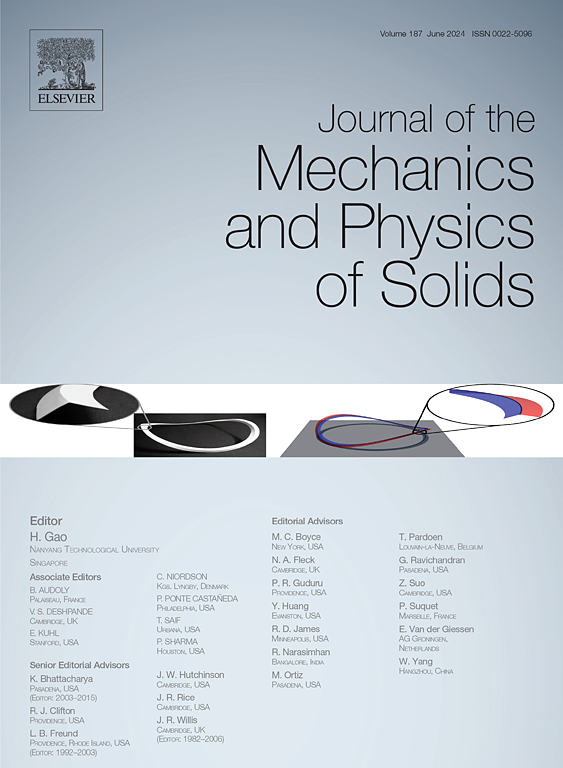Modeling semi-flexible biopolymer networks with geometrically exact, non-linear isogeometric beams
IF 6
2区 工程技术
Q2 MATERIALS SCIENCE, MULTIDISCIPLINARY
引用次数: 0
Abstract
Biopolymers are an important class of materials that comprise many biological tissues. Their semi-flexible nature sets them apart from most synthetic polymers. Thus, the development of material-specific models is an important step toward understanding their structure-function relationship. This, in turn, will enable us to understand biological tissues such as heart valves, arteries, and skin. Here we propose and test the use of geometrically-exact, nonlinear isogeometric beams and beam assemblies to model semi-flexible polymer networks. Beyond establishing and validating this modeling framework, we demonstrate its potential by exploring the deformations of individual fibers and of 3D semi-flexible biopolymer networks. We do so in networks of straight and undulated fibers and find that fiber geometry significantly alters the networks’ macro-mechanics. Additionally, we find that fibers undergo a well-preserved sequence of loading modes. Specifically, fibers first reorient and bend and are then uniaxially stretched. We further showcase our framework by successfully comparing a fibrin pure shear experiment against our model predictions. We believe that our modeling framework will be useful in continuing the investigation of the structure-function relationships of semi-flexible biopolymer networks and will thus provide insight into the mechanics of biological tissues.
建模半柔性生物聚合物网络几何精确,非线性等几何梁
生物聚合物是构成许多生物组织的一类重要材料。它们的半柔性特性使它们与大多数合成聚合物区别开来。因此,材料特定模型的发展是理解其结构-功能关系的重要一步。反过来,这将使我们能够理解心脏瓣膜、动脉和皮肤等生物组织。在这里,我们提出并测试使用几何精确的非线性等几何梁和梁组件来模拟半柔性聚合物网络。除了建立和验证该建模框架之外,我们还通过探索单个纤维和3D半柔性生物聚合物网络的变形来展示其潜力。我们在直纤维和波动纤维的网络中这样做,发现纤维的几何形状显著地改变了网络的宏观力学。此外,我们发现纤维经历了一个完好保存的加载模式序列。具体来说,纤维首先重新定向和弯曲,然后单轴拉伸。我们通过成功地将纤维蛋白纯剪切实验与我们的模型预测进行比较,进一步展示了我们的框架。我们相信,我们的建模框架将有助于继续研究半柔性生物聚合物网络的结构-功能关系,从而提供对生物组织力学的见解。
本文章由计算机程序翻译,如有差异,请以英文原文为准。
求助全文
约1分钟内获得全文
求助全文
来源期刊
CiteScore
9.80
自引率
9.40%
发文量
276
审稿时长
52 days
期刊介绍:
The aim of Journal of The Mechanics and Physics of Solids is to publish research of the highest quality and of lasting significance on the mechanics of solids. The scope is broad, from fundamental concepts in mechanics to the analysis of novel phenomena and applications. Solids are interpreted broadly to include both hard and soft materials as well as natural and synthetic structures. The approach can be theoretical, experimental or computational.This research activity sits within engineering science and the allied areas of applied mathematics, materials science, bio-mechanics, applied physics, and geophysics.
The Journal was founded in 1952 by Rodney Hill, who was its Editor-in-Chief until 1968. The topics of interest to the Journal evolve with developments in the subject but its basic ethos remains the same: to publish research of the highest quality relating to the mechanics of solids. Thus, emphasis is placed on the development of fundamental concepts of mechanics and novel applications of these concepts based on theoretical, experimental or computational approaches, drawing upon the various branches of engineering science and the allied areas within applied mathematics, materials science, structural engineering, applied physics, and geophysics.
The main purpose of the Journal is to foster scientific understanding of the processes of deformation and mechanical failure of all solid materials, both technological and natural, and the connections between these processes and their underlying physical mechanisms. In this sense, the content of the Journal should reflect the current state of the discipline in analysis, experimental observation, and numerical simulation. In the interest of achieving this goal, authors are encouraged to consider the significance of their contributions for the field of mechanics and the implications of their results, in addition to describing the details of their work.

 求助内容:
求助内容: 应助结果提醒方式:
应助结果提醒方式:


